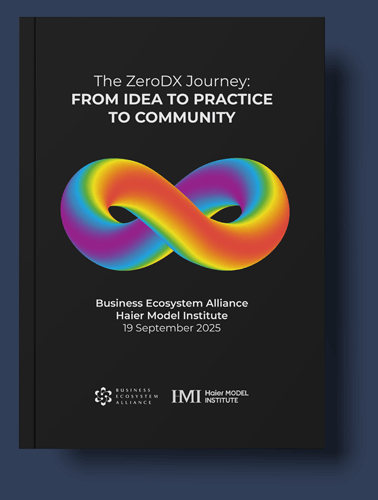Transformation towards an ecosystem: how to establish an ecosystem business while sustaining success in the core business
Karolin Frankenberger, Hannah Mayer, Andreas Reiter & Markus Schmidt
Can you think of a mobile operating system that does not rely on various players coming together, aligning structurally and managing their mutual interdependence for value to be created? Or a smart home system? Your go-to ride-hailing service? Or even your favourite coffee (assuming you’re siding with George Clooney on that one)?
Ecosystems abound, with digital platforms (such as those organized around iOS, Nest and Uber) as their most common manifestation. But make no mistake, ecosystems of all shapes and sizes, including the non-digital and non-platform ones (such as Nespresso), are fast superseding traditional firm structures.
While the digital pure players and startups of this world tend to be free of historical organizational baggage, most traditional firms need to find a way to establish an ecosystem business while maintaining success in their core business. That’s not to say that Apple, Google, and Uber didn’t need to overcome significant obstacles on the way to becoming leaders in mobile, smart home, and ride hailing; that’s only to say that Nespresso’s journey within incumbent Nestlé followed a different path. That’s because it had to address one main dilemma the others didn’t face: how could they maintain profitability in their legacy-based, traditional business activities (what we call the 1st S-curve) while reaping the full potential in a new ecosystem-based business (which we call the 2nd S-curve)? This dilemma of two S-curves is something that all incumbents face, and most of them fail and end up wasting money and time. At the same time, the management community (and frankly scholars) have been too concerned with defining and delineating ecosystems instead of helping practitioners get ecosystem strategy – and implementation – right. But there is light at the end of the tunnel.
Consider, for instance, Austrian waste management company Saubermacher. Founded in the 1970s and meanwhile earning 300 million euros in yearly turnover from waste management operations, Saubermacher is neither a tech behemoth nor a start-up. Instead, it is one of the many organizations with a traditional background (1st S-curve), looking to innovate towards the future (2nd S-curve). And that they did. They established “Wastebox” – a platform-based waste disposal solution, connecting construction companies with waste disposal firms via an app much more conveniently, transparently, and more user-friendly than before. Only two years after inception, Wastebox had garnered a significant valuation and Saubermacher was wooed by the global industry leader, Veolia of France, to engage in a partnership with them.
So, what did Saubermacher – and other successful transformers – do to nail what can only be described as a transformation rollercoaster? We conducted interviews with CEOs and other top executives at more than 100 globally leading companies to distill the textbook recipe for transforming towards an ecosystem. We found it takes five elements to master the transformation, and ecosystem thought leaders answer the following related five questions affirmatively.
Do you understand there’s a pressing need to act and transform?
The first step toward change is self-awareness, an old saying goes. So, the first step toward an ecosystem business is the realization there is a need to act and transform to begin with.
Ecosystems tear down traditional industry boundaries that have long served as barriers of competition. They redefine value creation and value appropriation mechanisms, and redraw the historically established lines between cooperation and competition. Industry dynamics are thus shifting in response to the introduction of digitally enabled ecosystems that span sectors. Ecosystems disrupt established industries, connect previously unrelated businesses, and give rise to novel value propositions and modular product-service bundles.
Many traditional businesses we spoke with feel threatened by newly emerging competition from tech players or startups, who appear to seamlessly build and integrate such ecosystem-based business models. Others observe trends in customer preferences that force them to transform as they become increasingly reliant on partners to bring about value propositions that satisfy customer needs.
The list of reasons to need to transform is long. Companies need to figure out which motives apply to them specifically and internalize the urgency to act upon them.
Do you have a comprehensive strategy – and supporting business models – in place to address both S-curves?
Once organizations have realized the need to transform, they will have to define a comprehensive strategy and the right supporting business models. Organizations need a sound strategy addressing how to safeguard and increase the competitiveness of their core business in light of newly emerging ecosystems. At the same time, they need to consider how ecosystem participation can help them expand their value network and generate additional growth, based on new ecosystem-oriented business models. They must also consider how to best manage interactions between the core and the new ecosystem business.
Most existing strategy tools are ill-fitted to this exercise. The majority of them focus on within-industry competition and are thus of little help when organizations must wrap their heads around ecosystem strategies and business models involving multiple players and industries. What is needed are new ways of thinking and perspectives on strategic portfolio management and digital initiatives that span beyond organizational boundaries.
When considering the expansion of product or service portfolios, incumbents need to make strategic decisions around when to set up collaborative ties with external players to bring about new offerings, or when to go it alone. Involving others in this process can give the incumbent access to new value pools. In return, they must give up some territory and think of new business models from the perspective of the whole ecosystem rather than that of just their single firm. This means, to make such ecosystem-based business models work, incumbents need to consider the contribution and needs of all players in the ecosystem, including partnering firms, competitors, and customers.
Do you have the right talent and mindset (i.e., the “soft factors”)?
The “soft side” of a transformation towards an ecosystem starts with sourcing the right staff and leaders. Across both S-curves, the most important lever in this respect are retraining and hiring. For instance, a steel company we spoke with built a dedicated digital academy to upskill employees in digital proficiency, thus investing in their employees’ long-term development. As far as leaders are concerned, the major challenge resides in reconciling two leadership approaches in one organization. While some traditional leadership qualities will continue to be important in select areas of the 1st S-curve (e.g., a zero-failure tolerance in production), it will become increasingly important on the 2nd S-curve to employ a transformational leadership style rather than an authoritarian-directive one. In fact, the CEO of a pharma company’s ecosystem venture told us, “Classic leadership models are outdated. We see leaders as servants who create a safe space for employees to perform at their best.”
On top of leaders and staff, a fundamental shift towards a modern, change-embracing corporate culture is needed if the transformation is to succeed and yield reputational spill-over effects. As incumbents need to quickly react to needs of customers and ecosystem partners, promoting a culture of customer-centricity and radical experimentation will be indispensable. Successful incumbents empower their employees to pursue new ideas independently and without unnecessary red tape.
Do you have the right (infra-) structure in place (i.e., the “hard factors”)?
The “hard side” of digital transformation relates to the structure, processes, and technology it takes to make the transformation work. The structural design of combining the ecosystem business and the core business in one organization will be a key consideration early on as incumbents need to set up an organizational design conducive to working with and learning from others, rather than in a silo.
Because organizations can no longer deliver value propositions independently but instead rely on collaboration partners, it is vital for them to open up and think strategically about a network of ties beyond firm boundaries early on. These ties can be manifold and include links to startups, company builders, and venture capital organizations but also to universities, thought leaders, tech hubs, players from other industries, and even industry competitors. For some topics that are hard to figure out single-handedly, an alliance with other players in the industry might make sense.
As far as processes and technology are concerned, managers should make sure that they let go of traditional approaches and switch to a set-up that allows efficient and flexible collaboration with other ecosystem players. In most cases, this will require an investment into a more open, adaptable IT infrastructure and agile development process to realize new requirements faster. Particularly when operating a digital platform ecosystem, such approaches are indispensable.
Do you know how to measure progress and results?
Let’s assume companies have tackled all the above. They are expecting bottom-line effects or else the whole ecosystem transformation would be futile. Where and how exactly the transformation has effects will differ across the two S-curves, so KPIs need to be determined specific to the respective S-curve (core business vs. ecosystem business) and the relevant stage (ask yourself: is my ecosystem business in its incubation phase, or have I started to scale and commercialize already?)
The KPIs should reflect a healthy mix of quantitative and qualitative measures, whereby qualitative KPIs can initially prevail in the new ecosystem business (during the incubation phase) and later (when scaling and commercializing) be displaced by quantitative ones. Setting objectives, assigning accountability, and ensuring transparency vis-à-vis the relevant stakeholders is almost as important as the KPIs themselves. This stresses yet again the crucial role of measuring impact because the age-old saying also holds in a digital transformation: only what gets measured gets done. But then, luckily – as waste manager Saubermacher experienced – what goes around does come around.
If companies have mastered all elements and survived the rollercoaster ride, ideally coming out of it all hyped on adrenaline and endorphins – this is not the end. Eventually their 2nd S-curve will become a 1st S-curve again as the original 1st S-curve ceases to represent any value to customers. And then the whole cycle starts anew. So, as you sit tight in your seat just as your rollercoaster car is about to embark on its next trip along the tracks, just remember Ginni Rometty, former CEO of IBM, who correctly pointed out: “The only way to survive is to continuously transform.”1
Karolin Frankenberger is a Professor of Strategy and Innovation at the University of St. Gallen/HSG, where she is also Director at the Institute of Management & Strategy and the Academic Director of the Executive MBA.
Hannah Mayer is a PhD Fellow at Harvard Business School, a PhD Candidate at the University of St.Gallen/HSG, a former Googler and management consultant.
Andreas Reiter is a PhD Candidate at the University of St.Gallen/HSG and a former consultant at a leading international management consultancy.
Markus Schmidt is the founder and CEO of QSID Digital Advisory and a former Executive VP at Bosch.
This article is adapted from the authors’ book The Digital Transformer’s Dilemma: How to Energize Your Core Business While Building Disruptive Products and Services (Wiley, 2020). It is an extended version of the authors’ Harvard Business Review article “The transformer’s dilemma”.
Footnotes:
1 http://fortune.com/2013/05/17/ginni-rometty-reveals-the-future-of-watson/


